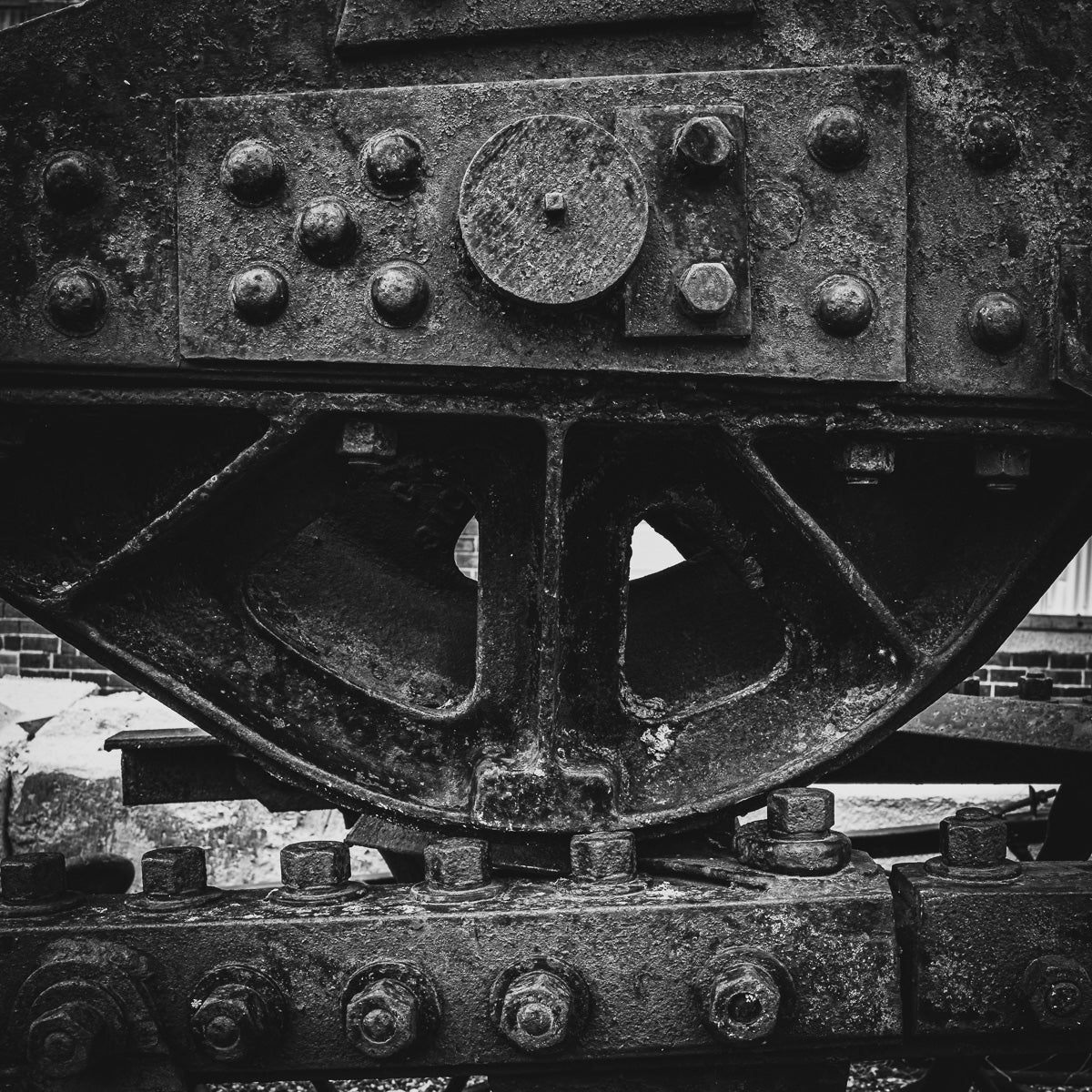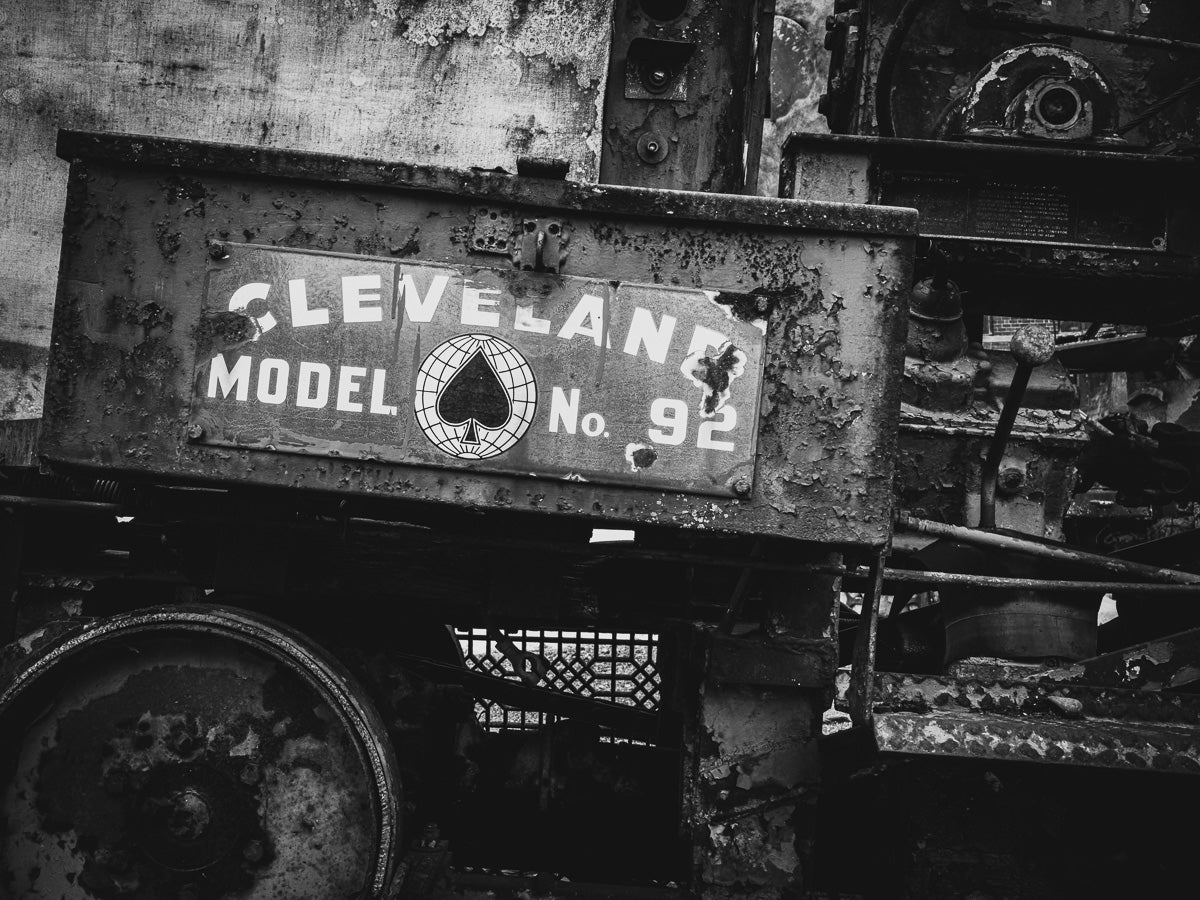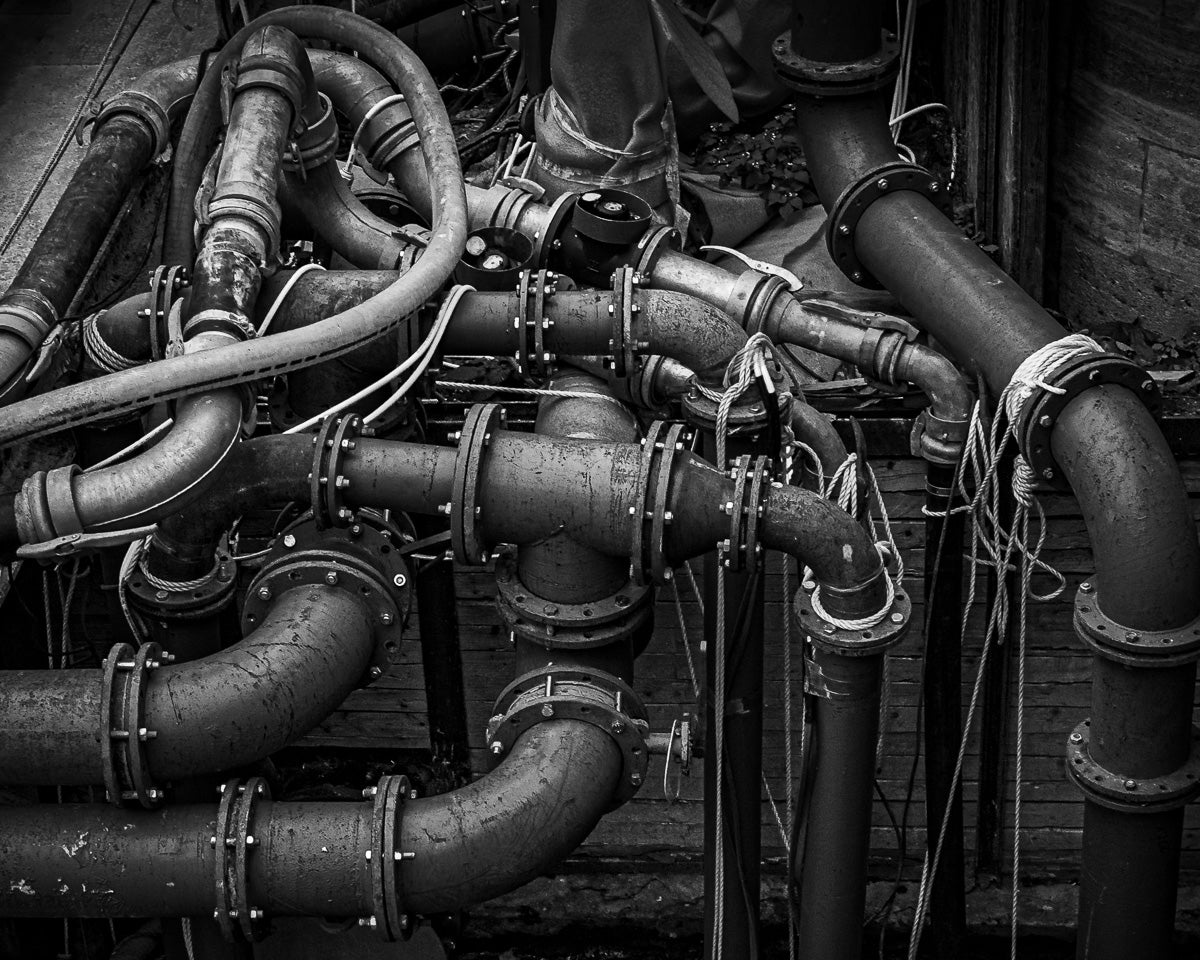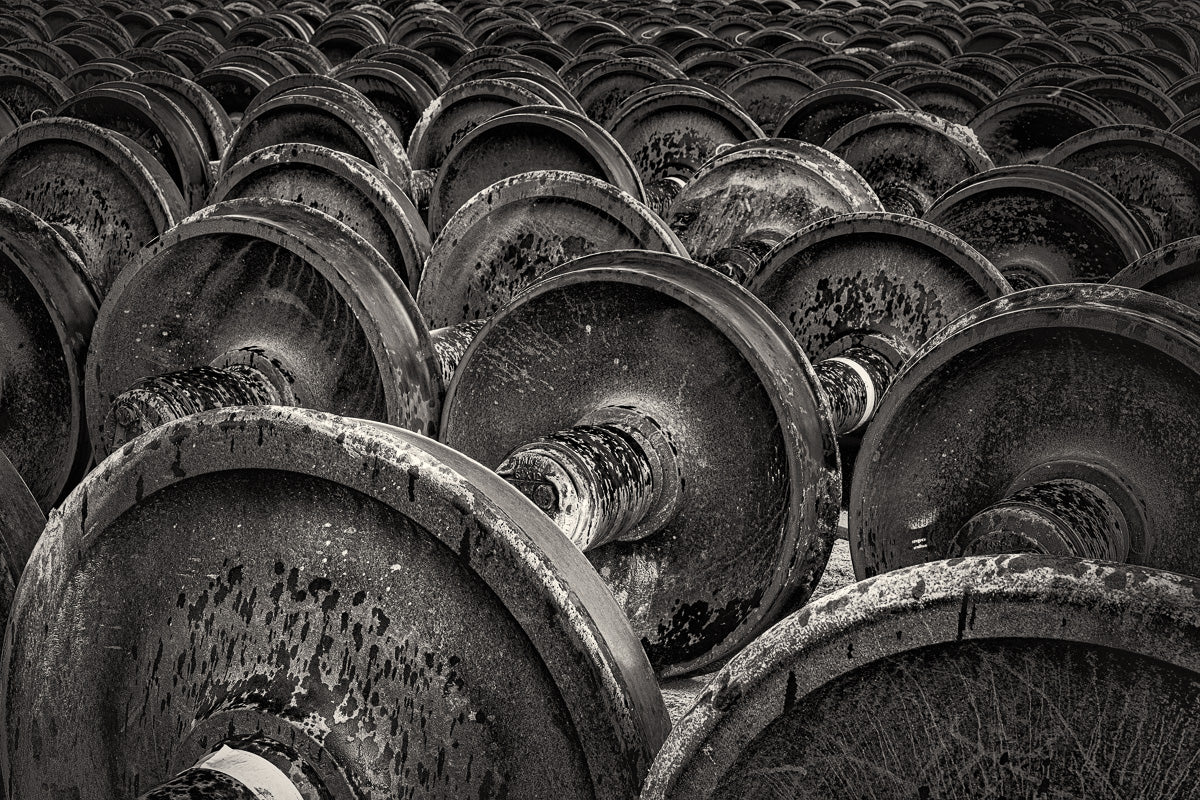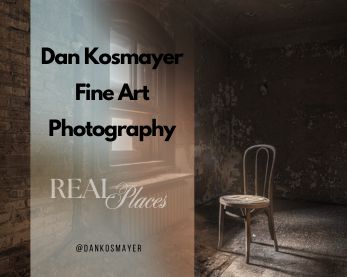Vintage Industrial Wall Art: Worn Metal / Forgotten Places
Industrial photography has a way of finding beauty in the broken. In my black and white art prints, I am drawn to worn metal and forgotten places – old factories, rusted gears, and time-worn machines that whisper stories of a bygone era. Each photograph in this collection is more than just decor for the wall; it’s a connection to history and hard work. Materials like reclaimed wood, with its rustic charm and durability, often feature in industrial decor, enhancing the rugged textures and historical authenticity of the space. Industrial photography, especially in monochrome, highlights texture and tone, transforming corroded steel and iron into compelling wall art. This digital exhibit guides you through some of my favorite pieces, each a chapter in an unfolding narrative about industry, decay, and the persistent allure of the past. Every image here carries a tactile sense of history. You can almost feel the flaking rust and cold metal through the photograph. I approach these subjects with a thoughtful and honest eye – thoughtful in observing the interplay of light and shadow on mechanical forms, and honest in portraying the grit and reality of these aging objects. As an artist, I want to capture moments that feel both familiar and new, each image a mix of detail and feeling. There’s a reverence in my work for these relics. By presenting them as fine art, I invite you to see what I see: art that’s personal, meaningful, and a little unusual – industrial relics that resonate with emotion and history.
Old Heavy Machinery – A Glimpse into the Industrial Past
A relic of the industrial age—its rivets, rust, and weathered steel echo the power and decay of forgotten work.[/caption] When I explored an old abandoned plant, I encountered Old Heavy Machinery looming in the quiet shadows. Its steel body, once painted with purpose, is now textured by rust and decay, each flake a testament to years of service. I was immediately drawn to the juxtaposition of strength and fragility: this machine was a titan of work in its prime, yet time has rendered it delicate in appearance, vulnerable to the elements. In the resulting photograph, I focused on the close-up details – rivets and bolts that now serve as markers of an era long gone, a face of a machine that time nearly forgot. Captured in black and white, every grease stain and dent is immortalized in rich contrast. The monochrome palette strips away distraction and lets us appreciate the intricate textures that only decades of labor can create. Each scratch and worn patch speaks to the machine’s history, yet an air of mystery remains – I honestly don’t know what task this machine performed in its working days. That uncertainty is part of the allure. By isolating this time-worn machinery from its context, I wanted viewers to ponder its story and imagine the hands that once operated it. This piece invites a quiet reflection on the relentless passage of time, making a bold statement on any wall as a fine art print that carries the soul of an industrial past within its frame.
Cleveland Model 92 – Testament to a Bygone Era of Industry
Cleveland Model 92—an industrial monument captured in monochrome, echoing strength, history, and stillness.[/caption] In the heart of an old factory, I came across the Old Cleveland Model 92 heavy machinery, standing silent and tall. This formidable piece of equipment immediately struck me as a stoic figure from a bygone era of heavy industry. In the photograph, the Cleveland Model 92 looms with a quiet dignity: iron and steel components layered with patina, each curve and bolt telling a chapter of industrial might and endurance. I composed the shot to emphasize its stoic presence, framing the machine head-on as if posing for a portrait. What I love in this image is the moody interplay of light and shadow across the machinery. Soft light streams through broken factory windows, caressing the rusted surfaces and throwing parts of the machine into deep shadow. This chiaroscuro effect adds depth and drama, turning the mechanical subject into a stage of contrasts. You can see how the gentle highlights kiss the edges of gears and levers, giving life to the otherwise cold metal. There is a serenity I feel when capturing these giants of metal; despite their size and former power, time has bestowed a quiet dignity on them. The monochrome tones further push the scene into a timeless realm, as if we’re looking back through history. This print isn’t just a documentation of old equipment – it’s a portal to the days of robust industry, inviting viewers to appreciate how even the mightiest machines must bow to time. I often find myself imagining the clamor of the workshop that once was, now replaced by silence and the soft click of my camera shutter. In sharing this piece, I hope others feel that profound sense of respect and nostalgia for the tools that built our world.
Iron Industrial Pipes – Geometry in Shadows as Industrial Wall Art
Intersecting lines and aged metal form an unintentional sculpture—an industrial rhythm frozen in time.[/caption] Not everything in this collection is a huge machine; sometimes it’s the simpler industrial elements that fascinate me. Iron Industrial Pipes is a piece that celebrates the unexpected artistry in everyday infrastructure. What drew me to this scene was the intersection of light and metal on a row of heavy iron pipes along a factory wall. In reality these pipes are rigid and utilitarian, built to channel fluids or gases in some forgotten plant. But in the late afternoon light, they transformed. The pipes cast long geometric shadows, and suddenly the whole arrangement looked like a modern art installation. In the photograph, the heavy pipes seem to bend and dance through their shadows, even though we know they are perfectly straight. There is a geometric dance happening: circles, lines, and repeating patterns created by the pipes and their silhouettes. I composed the frame to highlight this play of light and shadow, letting the natural contrast carve out shapes. The result is almost abstract – you could easily mistake the image for a planned design rather than a found scene. I love this contrast: the cold, hard metal versus the soft, ephemeral light. The black-and-white treatment accentuates this, reducing the scene to form and texture. Each pipe is edged by a highlight on one side and a deep shadow on the other, giving it volume and depth. The slight rust and wear on the metal adds texture, reminding us that these are not staged props but real pipes that have seen years of use. This photograph is as much about what isn’t there – the empty space and the darkness – as what is. It’s a reminder that beauty often hides in unexpected places. By finding art in something as ordinary as industrial plumbing, I hope viewers take a moment to look closer at their own surroundings; even a set of cast-iron pipes can become a captivating piece of industrial wall art when seen in the right light.
Massive Chains – Strength and Permanence
Weight and repetition—these heavy chains speak to an era of brute force and unrelenting purpose, now stilled in time.[/caption] Few things convey raw industrial power like a set of heavy chains. In Massive Chains, I captured a tableau of sheer strength and permanence deep in an old shipyard’s storage lot. Giant iron chains, links as large as your hands, lay coiled and piled against a dark background. I remember standing in front of them and feeling their weight with my eyes – an indomitable presence of metal. Through the lens of my camera, these chains took on a noble character. Each link was etched with gritty textures, scars from years of tension and load, now lit with a gentle light that revealed every detail. The resulting black-and-white photograph presents the chains as sculptural forms. Set against a nearly black backdrop, the links catch the light on their edges, each curve highlighted like the muscles of a working giant. There’s an almost monumental stillness to this composition. In reality, chains are meant to move and hold things together, but here these massive links lie dormant, allowing us to admire their form. The grunge details – pits of rust, flaking paint, and oil stains – speak to the trials and tribulations these chains have endured. I find that their still-life arrangement, seemingly ordinary, becomes extraordinary through the act of photographing. By coaxing out the contrast and texture, I wanted to show the indomitable strength that still breathes from these links of iron. This image has a bold, graphic quality that makes it a striking piece of wall art for anyone captivated by industrial or steampunk aesthetics. More than that, it’s a portrait of endurance – metal forged to pull weight beyond human strength, now at rest yet forever exuding an aura of resilience.
Detail of an Ancient Machine – Echoes of Industry
Every gear, groove, and bolt bears the fingerprint of labor—this relic tells its story in steel and silence.[/caption] Sometimes, a closer look reveals a world unto itself. Detail of Ancient Heavy Industrial Machine is an intimate study of just a part of a machine, so tightly framed that it becomes an abstract of shapes and textures. I discovered this old heavy industrial machine in a defunct mill, and what captivated me was the intricate detailing of its design – gears, levers, and panels arranged in a complex puzzle. By isolating a fragment of the machine, I wanted to highlight the craftsmanship of a bygone era. At first glance, the composition might look purely abstract with its interplay of circles and lines, but gradually the identity emerges: a knob here, a gear tooth there, all components of some antique mechanism. This photograph is about patina and precision. The metal surfaces are layered with rust and peeling coatings, evidence of time’s relentless march. Yet beneath the decay, the precise engineering is evident – every piece fit together with purpose. Such objects were built to last, and even in decay they retain a certain dignity. I chose a shallow angle and close focus to emphasize texture: you can almost feel the rough iron and the raised ridges of old bolts. The lighting was gentle, enough to cast soft shadows into the recesses and make the forms pop out in relief. There’s a quiet echo of industry in this image, as if the machine’s spirit still hums in the silence. It reminds us that the tools of the industrial age were not just functional but often beautiful in their complexity. Hanging this piece as wall art, one might simply enjoy the abstract forms at first. But the longer you look, the more it resolves into a conversation between craftsmanship and decay. It’s a testament to an era of iron and ingenuity, preserved in a moment that honors the machine’s historic allure.
Antique Tools – Craftsmanship of Heavy Industry
Tools of grit and repetition—these worn implements carry the memory of hands, labor, and the passage of time.[/caption] Not all stories of industry are told by gigantic machines; some live in the tools that built and repaired those machines. Antique Tools Used in Heavy Industry is a portrait of the implements of labor – the wrenches, hammers, tongs and other hand tools once held by workers of the industrial age. I arranged a set of old, heavy industry tools and let natural light fall across them to bring out their character. Each tool, with its handle and forged iron head, carries the marks of years of use. In the photograph, they stand as silent witnesses to the toil and ingenuity of generations past. This image has a particularly nostalgic aura for me. The black and white medium lends a timeless quality: you could imagine this scene existing the same way a hundred years ago. With color stripped away, attention goes to the scratches, the grain of aged wood, and the dark gleam of metal that has been handled countless times. There is a kind of reverence in how the light caresses these objects, highlighting a chipped edge here, a faded maker’s mark there. These tools may be simple, but they evoke the entire workshops they served – the clanging of metal, the sweat and skill of the people who used them. I wanted to showcase the rich history and craftsmanship imbued in these relics. Each hammer or spanner embodies the essence of industrial heritage, reminding us that behind every massive machine were human hands and simple tools making it all possible. This print, presented in museum-quality detail, connects directly to that heritage. It invites the viewer to appreciate the humble objects that underpinned heavy industry, letting us reflect on the craftsmanship of a bygone era and perhaps sparking a sense of nostalgia for the artisanal aspect of industry.
Ancient Industrial Machinery Abstract – A Collection Where Form Meets Memory
Where mechanics meet memory—this abstract vision of aged machinery reveals form over function, decay over design.[/caption] There are times when I frame a shot so tightly or at an unusual angle that the subject transforms into something abstract and new. In Ancient Industrial Machinery Abstract, I did exactly that. This piece is a study of shapes and forms taken from an old piece of machinery, so aged and corroded that nature’s hand has almost reworked its surface. At first glance, you see an arrangement of curves, bolts, and plate metal that could almost be modern art. It’s industrial detail rendered as an abstract composition. Only on closer inspection do the elements resolve into something recognizable – perhaps part of a vintage engine or factory press, now turned into an artistic pattern by time and my lens. I was aiming to explore the beauty of forgotten machinery in a way that appeals even if you don’t know anything about the machine itself. The photograph has a dynamic flow: a large curved form sweeps through one side of the frame while smaller details pepper the opposite corner, balanced like a painting. Rust has mottled the surfaces in a way that adds visual interest – shades of grey and near-black where the metal has oxidized, and brighter highlights on edges that catch the light. The effect is almost like a sculptural relief. This kind of image can complement a modern interior despite coming from an antique source, because it’s both historical and contemporary in feel. It’s a captivating piece of industrial art that asks the viewer to appreciate design and decay hand in hand. For me, creating an abstract from a real object is about finding the timeless elements in it – shape, contrast, texture – so that even as the memory of the machine’s original purpose fades, its visual impact remains. This print is a conversation starter, merging the forgotten past with artistic present, and it underlines my belief that the line between man-made and art can blur in delightful ways.
F-1 Rocket Engine – The Pinnacle of Power and Complexity
A labyrinth of engineered power—the F-1 engine becomes a monument to ambition, precision, and the industrial imagination.[/caption] Not all industrial subjects are derelict or from the 19th century. One of my favorite pieces ventures into the realm of aerospace, capturing a marvel of engineering: the F-1 Rocket Engine Detail from Apollo Saturn V. This is the same type of engine that sent Apollo missions to the moon, and here I had the chance to photograph it up close. In this image, I focused on the engine’s massive array of pipes, tubes, and valves – the labyrinthine guts that made up the most powerful rocket engine of its time. The resulting photograph is a celebration of mechanical complexity and human ingenuity. Despite being a piece of cutting-edge 1960s technology, the F-1 engine in black and white carries a classic, industrial aesthetic that fits this collection. The textures are astonishing: braided wires, ridged conduits, and bolted flanges all packed tightly in an organized chaos. I composed the shot to fill the frame with this complexity, almost overwhelming the eye with detail. Each part of the engine is meticulously designed, and in the monochrome print you can really appreciate the intricate engineering – every curve of a pipe and every groove of a bolt is rendered in sharp relief. There’s a sense of rhythm to the layout, a functional beauty where form follows function so perfectly that it becomes art. Standing in front of the real engine, I remember feeling small, humbled by the scale and the achievement it represents. I tried to channel that awe into the photograph. The way the light catches the metallic surfaces gives a subtle shine to the components, hinting at the polished precision they once had. This image combines industrial power and historical significance: it’s not just any machinery, but the machinery that enabled humanity to reach beyond Earth. As wall art, this print speaks to those who find inspiration in technology and history. It’s a bold conversation piece, merging the spirit of exploration with the aesthetic of industrial photography. Personally, I find it both sobering and inspiring – a reminder of what human hands and minds can build, piece by piece, to achieve the extraordinary.
19th Century Gears – The Beauty of Mechanism
Worn teeth and iron symmetry—these gears once powered a world now passed, preserved in quiet mechanical harmony.[/caption] The collection wouldn’t be complete without an homage to the elegant engineering of the 19th century. 19th Century Machinery Gears is a composition that showcases a cluster of interlocking gears from an antique piece of machinery. I’ve always been fascinated by gears – how their teeth fit together perfectly to transfer motion, and how they symbolize industry itself. In this photograph, a set of large and small gears fan out across the frame, almost like a mechanical flower. Each gear has its own unique texture and patina: some are smooth with age, others are chipped and rusted, all of them testaments to the craftsmanship of their era. I chose a straight-on angle and sharp focus so that the intricate design of each gear is clearly visible. The lighting was adjusted to glint off the edges of the teeth, creating tiny highlights that outline the circular forms. This emphasizes the interlocking nature – you can see exactly how one gear’s teeth nest into the next. The monochrome treatment here serves to enhance the detail and interplay of light and shadow on the metal surfaces. Without color, the viewer’s eye goes straight to the shapes and textures: the concentric circles, the radial spokes, the dark grease that still clings in crevices. There’s a sense of harmony in how these gears fit and work together, which I find deeply satisfying to look at. As I was photographing them, I thought about how these components were likely hand-drafted and cast over a century ago. There’s ingenuity and artistry in their very existence – functional art, in a way. I added a personal note to this piece in my journal: this image reminds me why I fell in love with vintage machinery. It encapsulates the idea that in the past, even utilitarian objects had aesthetic grace. The industrial elegance of those gears – their balanced symmetry and robust form – makes this print a favorite for viewers who appreciate steampunk vibes or vintage mechanical design. It stands as a tribute to human innovation, captured in a quiet, reflective composition.
Rusted Rail Car Wheels – Poetry of Decay and Journey on a Cart
Circular echoes of movement now halted—these rusted wheels rest beneath the weight of time and forgotten tracks.[/caption] We conclude our exhibit with a return to the quietly poetic: Rusted Rail Car Wheels. I found these train wheels on a forgotten stretch of track, where abandoned rail cars had been left to the elements. As I ventured around the derelict rail yard, the sight of these wheels stopped me in my tracks. Once, they carried goods and people across great distances; now they sit immobilized, half-claimed by rust. In the photograph, I aimed to capture that sense of time’s passage and lingering stories. The wheels are partially sunk in gravel and wild grass, their metal rims and spokes coated in thick rust that flakes like old paint. They are portrayed head-on and low to the ground, giving an almost monumental feel to these circular forms. What emerges in this image is a feeling of poetic melancholy. The rusted wheels speak to the ephemeral nature of human endeavors – even strong iron, given enough years of rain and sun, will yield to decay. Yet there is beauty in this decay. The corrosion has painted the wheels in deep oranges and browns (rendered as a rich range of grays in the black and white print), and the texture is rough and complex, like an organic sculpture. The background is soft and out of focus, just hinting at the overgrown tracks that lead off into oblivion. This puts all the emphasis on the wheels and their condition. I recall that the scene was incredibly quiet, with only a gentle breeze and the distant call of a bird. It felt almost like these wheels were recounting tales of journeys long past, but only in whispers. In composing the shot, I crouched low, letting the horizon of the image be the wheels themselves. The soft natural light of an overcast sky created a delicate gradient across the metal, which helps to highlight the intricate patterns of rust. Each layer of corrosion, each bolt fused in place, becomes a story of endurance. This photograph, to me, is a meditation on change: it urges one to reflect on how everything – even the mightiest locomotives and the steel wheels that carried them – eventually returns to stillness. As a piece of wall art, it brings a sense of history and introspection to a room. It’s not just about a train or industry; it’s about time, memory, and finding the quiet dignity in decay.
Walking through this “Worn Metal / Forgotten Places” collection, I hope you’ve felt the same connection that I do to these subjects. There is an emotional and artistic value in photographing rusted machinery and decayed tools that goes beyond documenting objects – it’s about capturing the soul of an era and the passage of years. Industrial photography in black and white has a unique power: it can transform cold machines into carriers of memory and meaning. Each piece in this exhibit is a story printed on museum-quality paper, hand-signed and crafted with care. Through my lens, I strive to show that old factories, tarnished gears, and abandoned rail cars are not dead relics – they are living art, with textures and tales that continue to inspire. In forgotten places, I find familiar feelings of nostalgia, resilience, and curiosity. Why do I shoot industrial subjects? Because I see honest beauty in their decay and strength in their history. There’s a tactile pleasure in the roughness of rust and a haunting aura in empty factories that sparks my creativity. By sharing these photographs, I’m offering windows into that world – inviting you to look closer at the walls and wheels that built our modern life, and to find the art in them. As you consider these works, imagine them hung in a space where you can visit these forgotten places anytime. May this collection of industrial black and white art bring you as much thought, feeling, and inspiration as it has brought me in creating it. Each frame is a journey, and I’m grateful to have you along on this visual voyage through time and toil.
